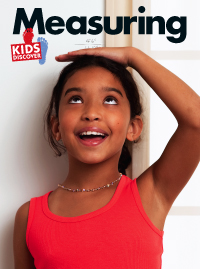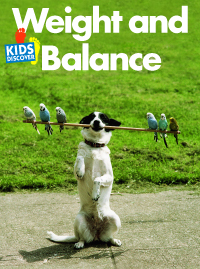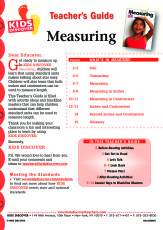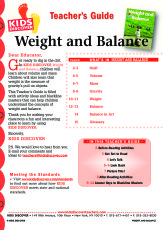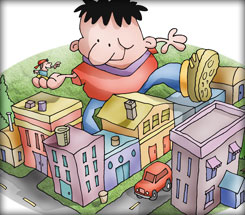 Wow. I had no idea of the number of definitions given to the word scale until I began researching this topic. It can relate to cartography (the ratio of distance between two points on a map against two actual geographic points), music (a series of notes arranged in a step-by-step ascending or descending order of pitch), your teeth (the stuff that hardens and eventually winds up paying for your dentist’s new boat), weights and measures (or, that flat thing that we always refer to in the bathroom as being way off), zoology (as on fish), corrosion, architectural drawings, yada, yada, yada. Though all are interesting definitions, we will stick to the simpler version for this conversation, that of the concept of big versus little.
Wow. I had no idea of the number of definitions given to the word scale until I began researching this topic. It can relate to cartography (the ratio of distance between two points on a map against two actual geographic points), music (a series of notes arranged in a step-by-step ascending or descending order of pitch), your teeth (the stuff that hardens and eventually winds up paying for your dentist’s new boat), weights and measures (or, that flat thing that we always refer to in the bathroom as being way off), zoology (as on fish), corrosion, architectural drawings, yada, yada, yada. Though all are interesting definitions, we will stick to the simpler version for this conversation, that of the concept of big versus little.
A child is a small thing. Compared to you and I, that is. And if you were to hold that child against something even bigger (say, Texas), he or she would hardly show up on the radar at all. Conversely, place that same child in close proximity to an anthill (if they aren’t there already) and you will see how awesomely large most children are.
It’s all a matter of scale, and understanding what it means to be big or little. Most of the time, we feel the need to measure ourselves and the objects we associate with against a standard of some kind. To wit; football fields, blue whales, city buses, the Empire State Building, and Boeing 747s are quite typical “go to” standards for most really large things these days, and heads of pins, little fingers, atoms (though I’ve yet to actually see one), pennies, and periods on a page usually help us fill in how small something can be. “But Mr. Blogger… is there a way to explain these senses of scale to my kids without going down the Fantastic Voyage path, or worse yet, renting the DVD of The Attack of the 50 Foot Woman?”
Oh, I’m so glad you asked. There are many ways to teach kids about scale, but the most memorable are sensory experiences involving a few props and (most importantly) a vivid imagination.
Going larger than life is relatively easy. Toy manufacturers have banked on the preoccupation with kids to “rule” something for many years. Barbies, Hot Wheels, train sets, doll houses, and Legos all serve to put your child in a different universe where they are by far the largest being. But a trip to the toy store isn’t really necessary. Save a few cardboard boxes (cereal boxes work well), some water bottles, a paper towel tube or two, and help your kids build their own miniature city. Cut holes for windows, paint, and assemble. Stack and glue boxes together for the occasional high rise, and be on the lookout for small, bushy branches that can be trimmed from a tree and stuck into the ground to serve as miniature trees. Be sure to include things like stores, hospitals, or even the occasional mall. Use string to designate the edges of roads, or if you plan your city on a paved surface, use chalk to layout your streets, replete with yellow lines and crosswalks. A rough-cut section of aluminum foil with the edges curled under will serve well as a small lake (rivers too). Use paper cups as trash cans and add large rocks for that suburban “vibe.” And don’t get in a hurry. The best mini-towns are ones that are added to over time. Add Hot Wheels or Lego people to the mix and the kids are easily on their way to feeling fifty feet tall.
On the flip side, let’s discuss heading in the other direction, or “shrinking” your offspring. Swimming noodles with a bit of clothes hanger wire threaded inside (to hold their shape) can make huge paper clips, or if properly adorned and trimmed, can become very large crayons. Rigid styrofoam (from a home center) can be trimmed and painted into all kinds of larger-than-life items such as combs, wrenches, hammers, gigantic pieces of bread (paint the edges brown) or slices of cheese. An oversized remote (we all have one, or two, or five) or cell phone can be constructed by gluing some foam together (use Elmers or a hot glue gun), trimming with a serrated knife (give the kids some help here too), shaping a bit with a rasp if you’re a true artist, and adding buttons made from plastic lids. (Whenever you paint styrofoam, use latex paint as enamel-based paints will dissolve the styrofoam). Large, black plastic trash bags can be stuffed with newspaper and twisted into all manner of gigantic bugs with swimming noodles for legs. Ick!
Be sure to always bring your child’s imagination into play, and not just within the confines of his or her play area. Ask them to imagine buildings downtown as shoe boxes, the trees in the park being pieces of broccoli, or your family car having just come from a blister pack at Toys R Us. Though I’m guessing you paid a bit more for it…
Teach. Learn. Enjoy!
